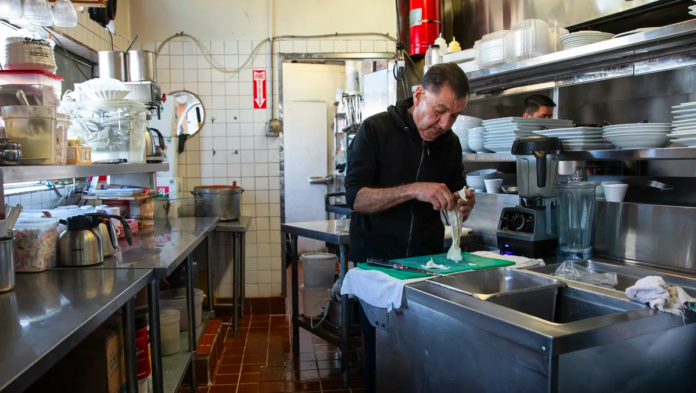
By
A California workplace safety board today approved a long-delayed rule requiring most employers to reduce the risks of extreme heat for indoor workers.
It applies to all employers except state prisons and local jails, and will particularly protect workers in warehouses, restaurant kitchens, manufacturing plants and any other indoor workplaces that are not fully air-conditioned.
The Occupational Safety and Health Standards Board unanimously approved the rule with little discussion — then urged the Office of Administrative Law to fast-track it so that it can be in effect by August.
Under normal administrative schedules, it will go into effect in October, leaving workers unprotected the rest of the summer.
Under the rule, when it is 82 degrees employers will be required to provide cooling areas and monitor workers for signs of heat illness. When it is 87 degrees, or for workers who labor near a heat source or must wear restrictive clothing on the job, businesses must take further measures, including:
- Cooling the worksite to 82 degrees or lower, if feasible;
- Adjusting schedules, allowing more breaks, slowing the rate of production or rotating workers through assignments;
- As a last resort, providing protective equipment such as personal fans or cooling vests.
The Warehouse Worker Resource Center, one of the primary advocates for the rule, applauded the approval.
“The road to get to the vote today has been long, but we hope there are no further delays and employees and employers are informed of these new protections before summer’s end,” Tim Shadix, the center’s legal director, said in a press release. “As we experience more extreme heat and longer and hotter summers, especially in the Inland Empire, it is absolutely essential that employers do more to prevent heat illness.”
Excessive heat can cause nausea, vomiting, fainting and, in the most extreme cases, heat stroke leading to organ damage or death. In California, seven workers died from indoor heat from 2010 through 2017.
Regulators hope the rule will reduce workplace heat injuries by 40% by 2030; an economic impact study conducted by the Rand Corp. estimated that it will cost employers statewide $215 million in the first year and about $88 million annually afterward, mostly for employers to install AC or fans or provide cool-down areas.
The rule’s final approval today capped a dramatic three months of actions that further delayed a regulation the Legislature first called for in 2016. A law passed that year called for the board to approve a rule in 2019; at the time, labor-friendly politicians were responding to reports of workers falling ill from the heat in a then-booming warehouse industry in the Inland Empire.
Five years later, the proposal was set for the board to approve this March, but Gov. Gavin Newsom’s administration pulled its support for the rule the night before the meeting over cost concerns to state prisons, several of which are in desert regions and which employ not only correctional officers but other staff such as health care workers.
The board, appointed by Newsom, lashed out at the administration over the move. Newsom this month removed member Laura Stock and demoted the board’s chairperson Dave Thomas who were among the most vocal. At today’s meeting, new Chairperson Joseph Alioto praised both as “two dedicated public servants” who contributed to “extremely significant, nation-leading regulatory achievements” for worker safety.
Meanwhile, the state’s workplace safety regulators scrambled to find a way to pass a rule the administration could support, opting to exempt correctional facilities.
Some employers’ groups, who have objected to the rule for years, remain unsatisfied, citing costs and confusion between the rule and the outdoor heat requirements, which apply for outdoor workers when it is 80 degrees.
“We do remain concerned about the feasibility for small employers, particularly those who don’t control the physical structure that their businesses are in, if you rent space as a restaurant, places like that, to create the required cool-down zones,” said Robert Moutrie, policy advocate at the California Chamber of Commerce.
The rule makes California the third state to protect indoor workers from heat; it was the first state to approve such a rule for outdoor workers nearly two decades ago after the heat-related deaths of four farmworkers.
Nationally, the Biden administration is considering a heat protection rule for all workers.

